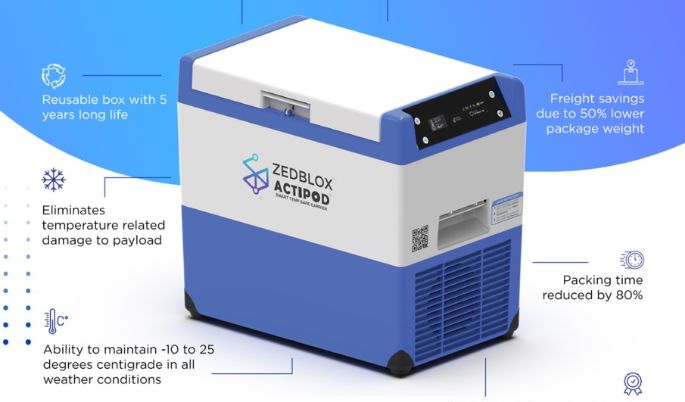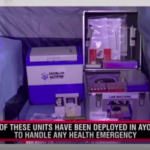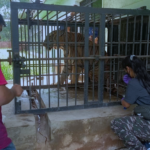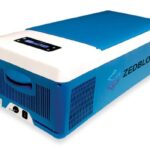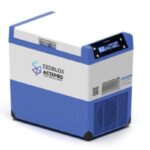Vaccines are considered as one of the most essential public health measures, saving millions of lives each year. Vaccines are responsible for the elimination of smallpox, and the world community is actively attempting to eradicate polio. High vaccine coverage rates are necessary to achieve current disease elimination and eradication objectives. An efficient cold chain is essential for ensuring that effective vaccinations reach their intended population in an equitable and timely manner.
Vaccines are biological products that degrade over time and must be stored within specific temperature ranges from the maker to the recipient. The loss of potency may be hastened when exposed to temperatures outside of this restricted range. Prior to 2007, the focus was on researching the effects of vaccination heat exposure. Exposure to cold temperatures, on the other hand, is similarly harmful to the quality of many vaccinations since the procedure leaves them inert. When exposed to cold temperatures, the adjuvants in certain vaccinations clump together, impairing the vaccines’ immunological capabilities.
Vaccines are extremely sensitive to temperature fluctuations and must be kept cold, but not frozen, during their entire trip, beginning with the factories where they are manufactured and ending with the patient receiving an Immunisation shot at a clinic. They spoil if exposed to excessive heat. Certain vaccinations, such as those for diphtheria, tetanus, and hepatitis B, lose efficacy when exposed to frigid subzero temperatures because the active components in the antigen solution freeze up.
Cold Storage Logistics Through The Years
Absorption refrigerators were the sole choice for areas without grid energy when EPI cold chains were formed in the 1970s. Several of these devices were pre-qualified and listed in WHO Product Information Sheets (PIS, the pre-qualification procedure that came before PQS). By the early 1980s, many solar battery-powered freezers were being tested in small-scale pilot experiments in developing-country EPIs. Batteries were employed to balance out the availability of electricity to the refrigerators—without them, power would only be available when the sun was shining, but refrigerators must remain cool throughout the night as well as during periods of cloud and precipitation.
Early off-grid technologies faced performance issues in field deployments, such as constant adjustment of absorption devices, which require frequent maintenance and an operational supply chain for fuel. The World Health Organization (WHO) addressed these issues in 2008, but no absorption devices have successfully demonstrated compliance. Traditional solar battery-powered refrigerators faced challenges, with batteries often requiring regular maintenance and a shorter lifespan than refrigerators and solar panels. Solar energy was also susceptible to theft, compromising the performance of refrigerators. SDD refrigerators were developed to address these challenges, powered directly from solar panels, requiring innovations in design to maintain cold temperatures even during cloudy weather.
Passive cooling systems, such as cold boxes and vaccine carrier boxes, have emerged to offer cooling during vaccine delivery and Immunisation outreach. The WHO PQS defines cold life as the time between adding coolant packs and closing the container lid until the temperature of the hottest point in the vaccine carrier box and storage compartment surpasses +10°C. However, the cold life is temperature-dependent and reduces when temperatures are above freezing. Until the decade, best-performing cold boxes had cold lifetimes of 2-6 days, while vaccine carrier boxes had 17-50 hours. As insulation technologies like vacuum panels and high heat resistance gels became available, engineers began exploring cold box manufacturing with weeks’ cold lifetimes.
Limitations Faced By the Cold Chain Logistics
There are mostly three critical issues impeding WHO’s ambition to establish routine Immunisation services globally: the lack of systems to monitor thermosensitive vaccine temperature, insufficient storage, and transport equipment, and a lack of trained staff. To address these difficulties, WHO consultants developed a strategy document and plan of action, focused on vaccination distribution and administration technologies and training materials. The approach called for different “vaccine stores” based on a pre-existing distribution system, beginning with a central or national store and ending with stationary, regional health institutions. This cold chain expanded to “outreach sessions” done in areas remote from health institutions on a regular basis.
The three most important challenges to be resolved while transporting the vaccines in the cold chain are
- A lack of temperature monitoring devices for thermosensitive vaccinations.
- A lack of proper vaccine storage and transportation equipment.
- A scarcity of properly qualified personnel to handle vaccinations.
A Lack of Temperature Monitoring Devices for Thermosensitive Vaccinations
The original EPI vaccines were sensitive to heat and freezing, but the extent of sensitivity was not fully known. Due to the lack of assessment of heat exposure after distribution, strict requirements governed vaccine and vaccine carrier box handling and storage temperatures. In 1976, the standard procedure for temperature monitoring was to read and record the temperature in each vaccine refrigerator twice daily and display the temperature profile on a chart each month. Large national stores had continuous temperature recorders with an ink stylus. Compliance with standard procedures was good in some cases, but in others, it was poor and unreliable. The lack of routine temperature monitoring also made determining when cooling equipment needed maintenance challenging.
A Lack of Proper Vaccine Storage and Transportation Equipment
There were several challenges to ensuring vaccines were stored at the recommended storage temperatures. The most critical challenge was the scarcity and poor quality of energy available to refrigerate vaccines and freeze ice packs for transport. Electricity was absent from two-thirds of health facilities, making it impossible to use standard electric-compression refrigerators. Absorption-type refrigerators, which could be run on kerosene, gas, or electricity, were used in non-industrialized countries but could not maintain the temperature range required for vaccines or freeze enough ice packs for vaccine carrier boxes for transport. Additionally, the fuel source in rural areas of developing countries was often polluted with water, further reducing performance and increasing maintenance needs.
The short cold life of passive-cooled containers was another challenge. Insulated containers, including larger boxes for bulk vaccines and hand carriers for immunization outreach activities, were needed to transport vaccines in high and low ambient temperatures. Picnic boxes and carriers cooled by frozen ice packs were unsuitable for transporting vaccines due to their short cold life, insufficient performance for routine outreach lasting one or two days, and being fragile and not interchangeable.
A Scarcity of Properly Qualified Personnel to Handle Vaccinations
Developing temperature monitoring and cooling equipment was a significant technological challenge, but managing the system was even more challenging. This issue became apparent after smallpox eradication, as countries launched national immunization programs. Initially, there was rarely a single manager in charge, and most programs lacked mid-level managers or logisticians. Consistent policies, procedures, and training materials were lacking for guidance.
Innovations for the Cold Chain Logistics Through The Years
The World Health Organisation envisioned an end-to-end temp surveillance system for vaccines in the cold chain. Companies in the US and Switzerland, including Berlinger & Co. AG, developed a cold chain monitor (CCM) based on blue wax absorption on a visual track. This system monitored vaccine shipments from manufacturers to countries and was used to monitor stores at all levels. In the late 1970s, PATH and WHO collaborated to track heat exposure of individual vials of vaccine.
PATH and Temptime Corporation developed a vaccine vial monitor (VVM) based on polymerization technology, which allows health workers to determine if a vaccine has been heat damaged. WHO now requires all vaccines purchased through the United Nations Children’s Fund (UNICEF) to use VVMs.
Despite the VVM solving the lack of temperature monitoring, challenges remained, such as determining when and where temperature deviation occurred, whether it was due to faulty equipment or poor practices, and how to determine if a vaccine had been damaged by freezing exposure. Twenty years after the CCM, the Swiss company developed an electronic 30-day temperature recorder (30DTR), which is now available as both a standalone recording device and a remote recording device. Electronic recorders have become the gold standard for larger vaccine stores, allowing for quick response to temperature alarms and analysis of refrigerator performance.
The search for reliable vaccine refrigeration equipment began with modifying low-cost refrigerators and freezers used to store food in the home. To perform well enough to store vaccines in areas of intermittent energy, polluted fuel supply, and high and low ambient temperatures, modifications were made to the design of walls and cooling units. Electrolux created a tiny refrigerator family for health centers that combines a regular absorption cooling unit with a new 25-l long-range cold box designed before for vaccine carriage. Many of these refrigerators are still available, despite the fact that the market for absorption refrigerators is shrinking.
To maintain vaccine storage temperatures during power cuts and ‘brown-outs,’ an engineering consultant from the Consumer Association Laboratory modified a domestic chest freezer with an internal lining of water containers. The Ice-Lined Refrigerator (ILR) was configured to maintain correct temperatures and remain stable with as little as eight hours of energy per day after the lining was frozen. Today, the ILR is the preferred vaccine storage method because it ensures constant chilling in areas where grid power is unpredictable.
Three improvements aided the nations’ success by pushing the process of introduction and scale-up and verifying the accuracy and legitimacy of manufacturers’ performance promises. Direct engagement between WHO technical employees and consultants with manufacturers and individual developers was one of these improvements, as were engineering laboratories used to test new goods, and the WHO/PQS system updated UNICEF and other local management bodies.
The European Immunization Programme (EPI) aims to achieve high coverage for selected vaccines through a set of standard procedures. In 1976, WHO distributed the ‘Blue Book’, which served as the basis for developing future policies and training. Staff at all levels of national immunization programs received training and support to address the global standard operating procedures of the EPI. The final critical human resources solution was training targeted to users and repair technicians of refrigeration equipment used to store vaccines.
The Future of Immunisation Supply Chain
Cold chain protocols and equipment now hinder the supply of immunization services. To solve this limitation, vaccinations are disseminated inside the cold chain for as long as refrigeration is available. If the cold chain fails, vaccinations can only be used if the VVM indication permits. The number of vaccines that have been pre-qualified for ‘Controlled Temperature Chain (CTC)’ is increasing, although progress is gradual. The Polio Eradication Initiative (PEI) and recent successful studies of off-label vaccine usage have resulted in higher rates of immunization coverage. The ultimate aim for all vaccines should be to eliminate refrigeration at +2C to +8C from the whole supply chain, with equivalent on-label storage rules.
The present vaccination distribution system is built on techniques and ideas from 40 years ago in order to achieve quicker, more reliable delivery. vaccinations are distributed at several levels, with each level collecting fresh supplies or receiving given vaccinations. This combination of collection and delivery results in inconsistent, unpredictable vaccination supply and poor cold chain practices, including an increased risk of vaccines freezing during transport. High-performance management of the regular vaccination supply chain standardizes vaccine distribution to pre-set circuits of stores, ensuring that the frequency of re-supply is as high as feasible.
Distribution speed may be boosted by minimizing the number of storage stages and optimizing the route used for each delivery circuit by selecting ideal store sites and lowering ‘reserve’ stock levels. Pre-planned, dependable, and punctual deliveries, together with quantity supervision, assist to avoid stock-outs and surplus stock accumulations.
The supply chain continues to be a barrier to reaching unimmunized communities with limited access. These people are divided into three categories: partially immunized persons who are unable to finish the sequence of contacts, easily accessible populations living in peri-urban regions who refuse immunization or are unwilling to participate, and those living in rural areas who are physically difficult to reach.
Remote communities, such as those living on rivers, mountains, islands, and nomadic tribes, may need a ‘heroic’ outreach strategy that can cost up to five times as much as it does in metropolitan areas to properly immunize a kid. In these distant places, integrating immunization programs with other specified services may assist share the expense of outreach. New technologies that simplify and expand the cold chain should lower costs while simultaneously increasing coverage.
CONCLUSION
As the pharmaceutical business evolves and expands, the requirement for efficient and dependable cold chain logistics has grown in importance. When developing sophisticated temperature-sensitive items such as vaccines, it is critical to guarantee that these products remain within a certain temperature range in order to retain their efficacy and safety.
Temperature monitoring is critical to preserving the cold chain integrity of these items. Vaccine carrier boxes and cold boxes are essential for storing and shipping temperature-sensitive items, and the use of specialized technology such as data loggers and real-time monitoring systems ensures that these products stay within the specified temperature range.
Temperature monitoring serves to prevent waste in the pharmaceutical business and maintain regulatory compliance, in addition to assuring the efficacy and safety of these goods. In the present global health crisis, the right use of vaccine carrier boxes and cold boxes, as well as the adoption of dependable temperature monitoring systems, are critical because they assist ensure that vaccinations are conveyed safely and effectively to their intended users.
As we look to the future of the pharmaceutical sector, the utilization of cold chain logistics and temperature monitoring will become even more important. The development of new temperature-sensitive products, as well as a more complicated worldwide supply chain, will boost the demand for dependable and efficient temperature monitoring systems.
ZedBlox ActiPod is a novel device that assures the safety and efficacy of temperature-sensitive goods throughout transit and storage. Its dependable temperature monitoring technology, together with its long-lasting and reusable design, makes it a dependable and necessary tool for pharmaceutical firms and healthcare institutions.
The pharmaceutical industry’s future is significantly reliant on the cold chain logistics infrastructure, particularly for temperature-sensitive items such as vaccines. Maintaining the integrity of the cold chain requires the use of high-quality vaccine carrier boxes and cold boxes, as well as dependable temperature monitoring devices. Temperature monitoring aids in the safety and efficacy of these products, as well as in reducing waste and ensuring regulatory compliance. Given the ongoing worldwide demand for temperature-sensitive items, it is critical to take the required precautions.

